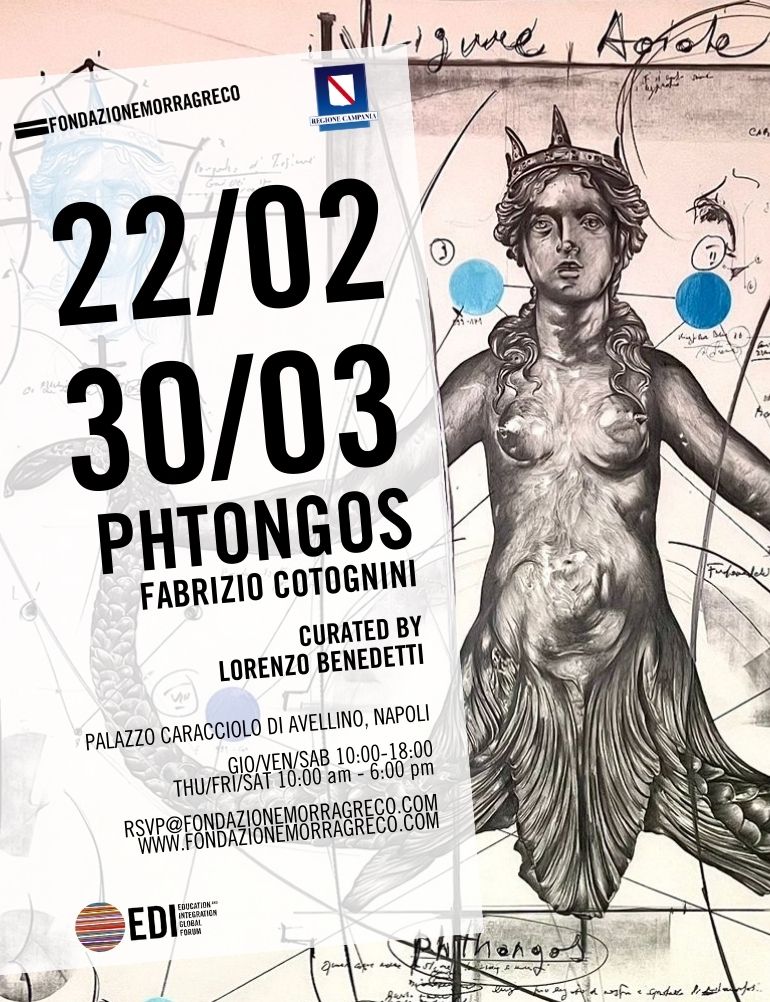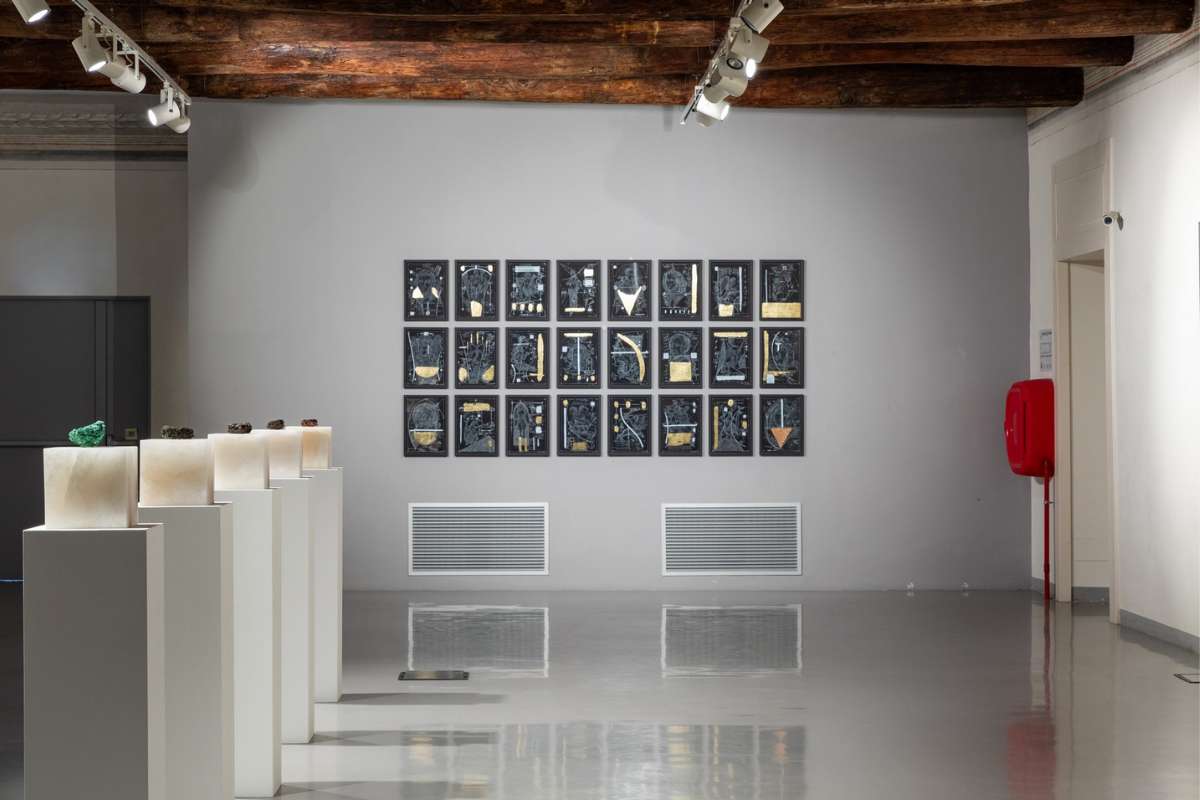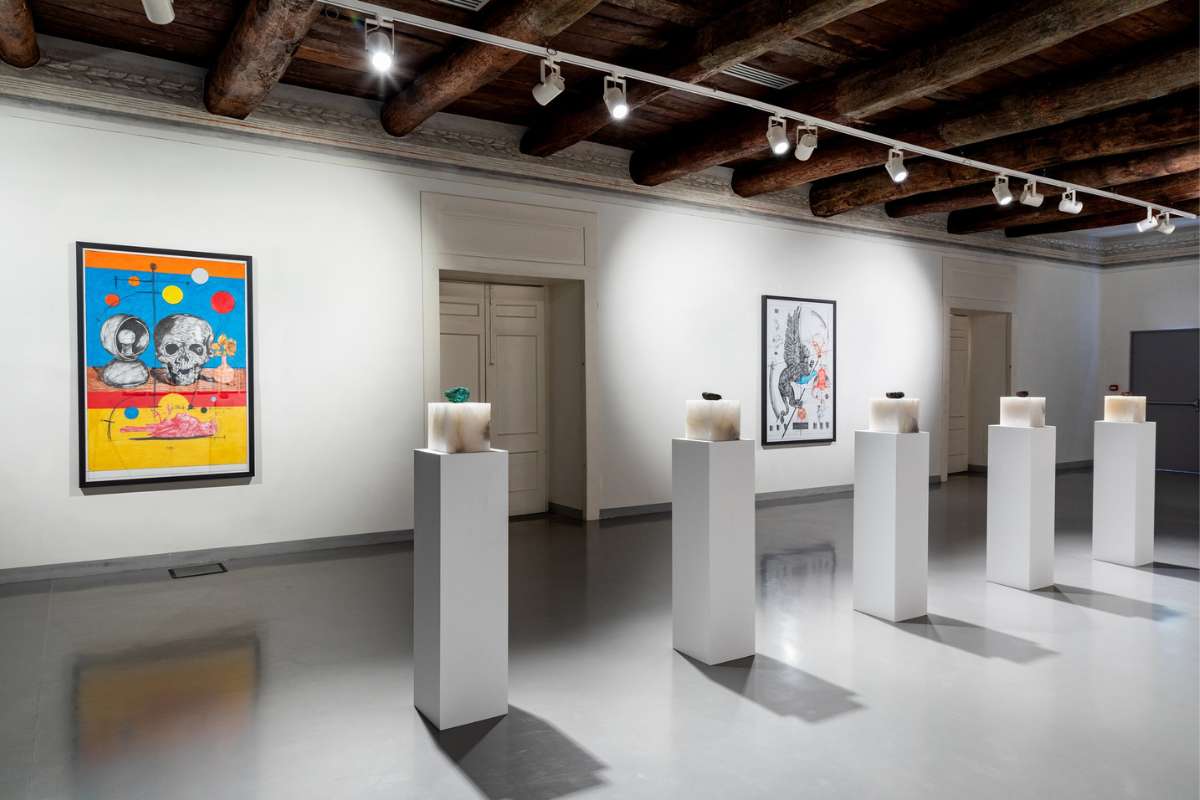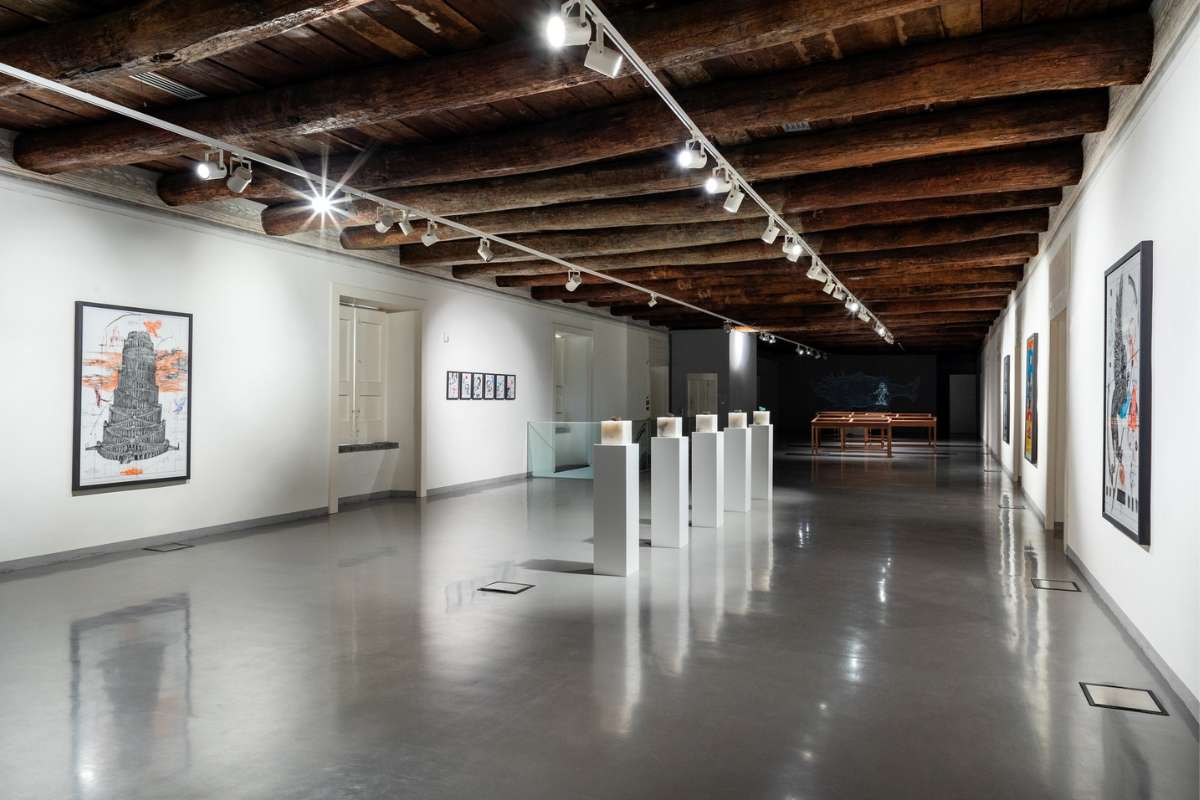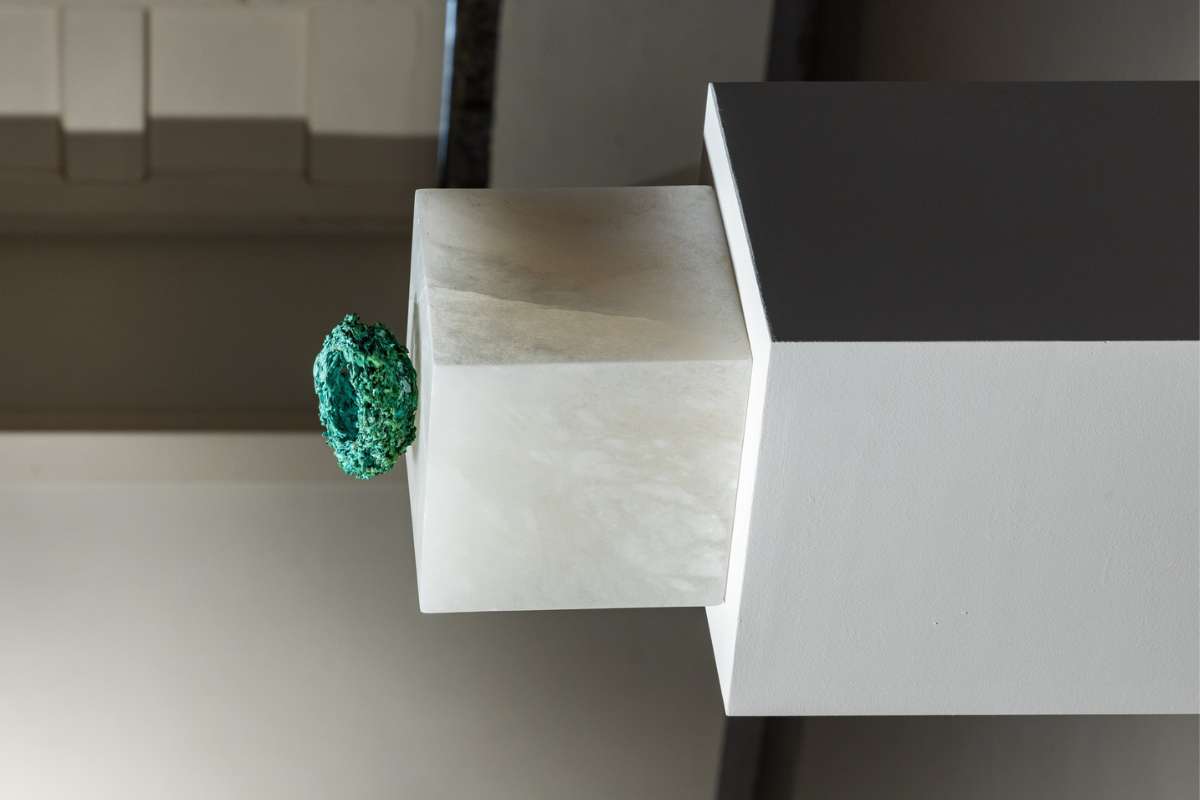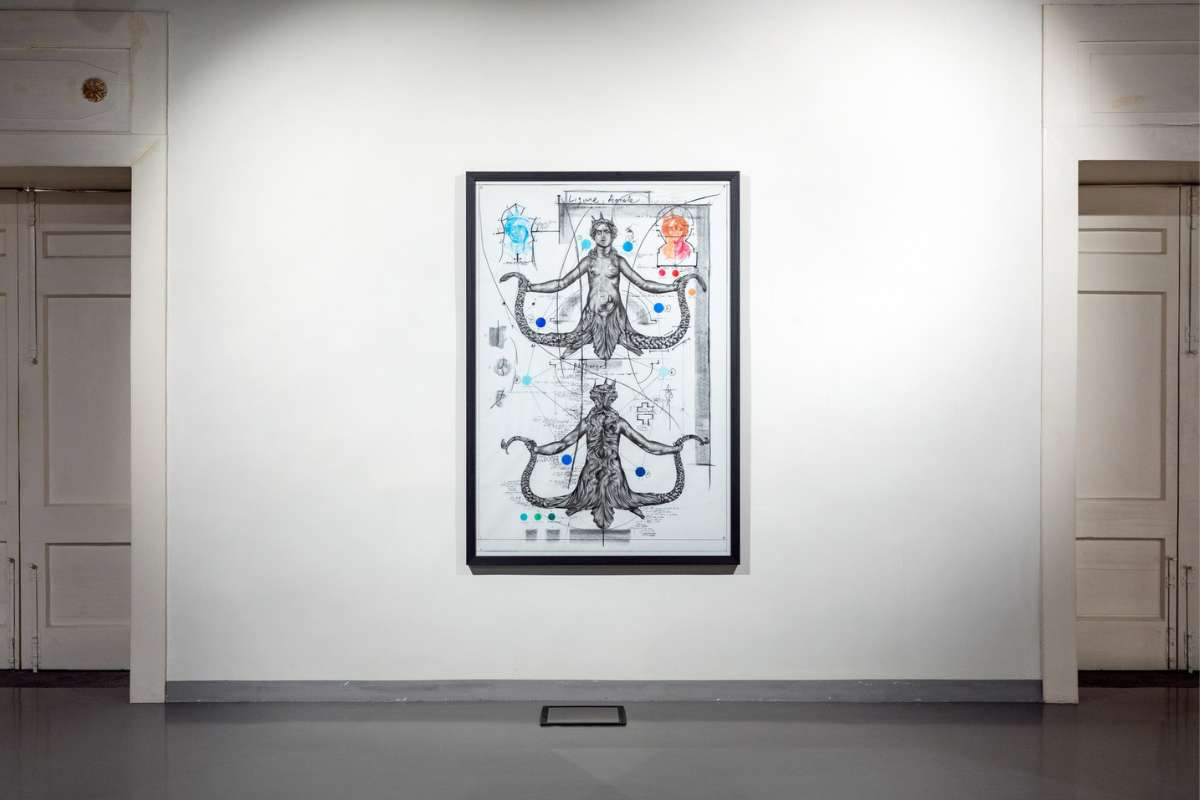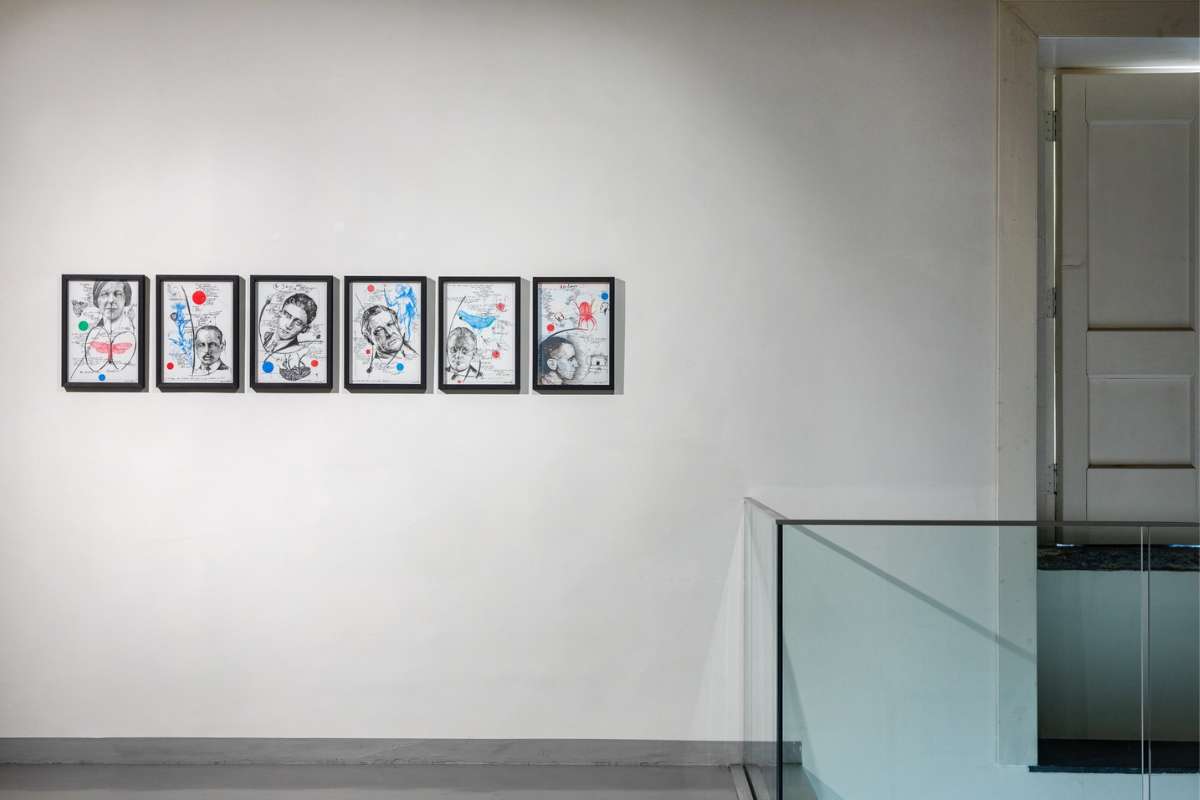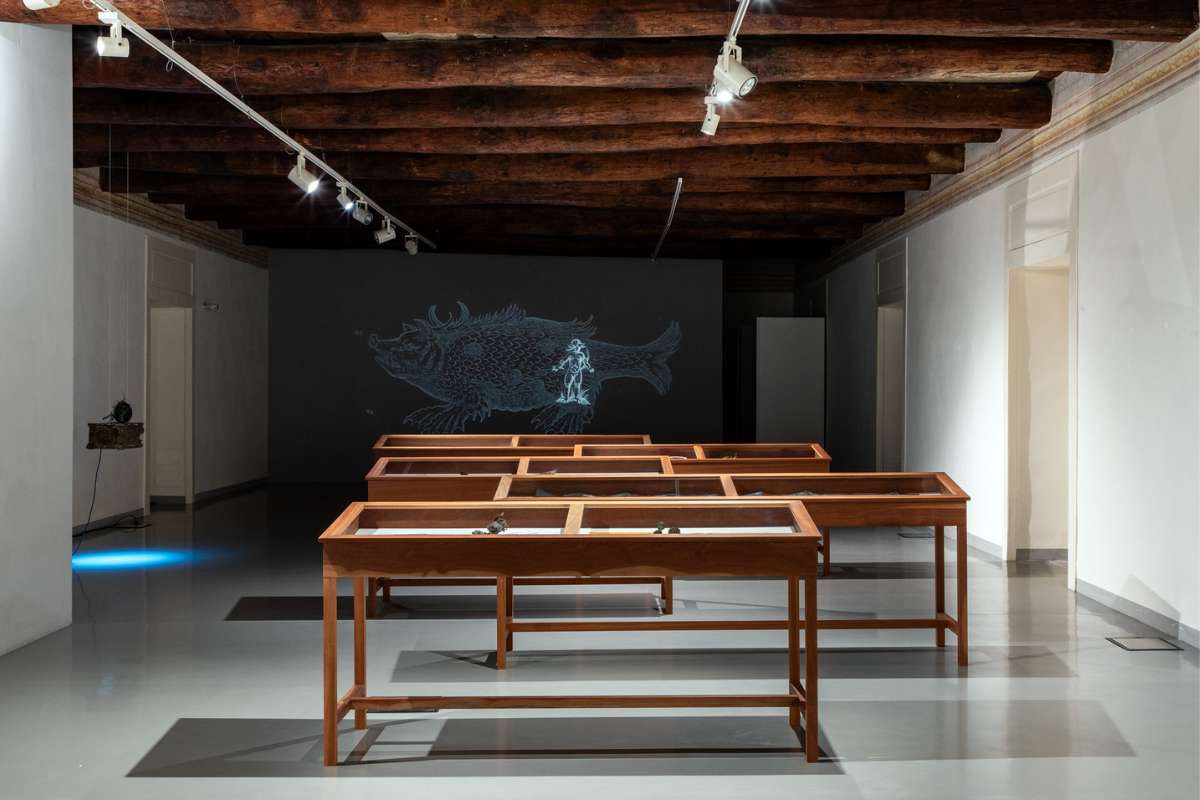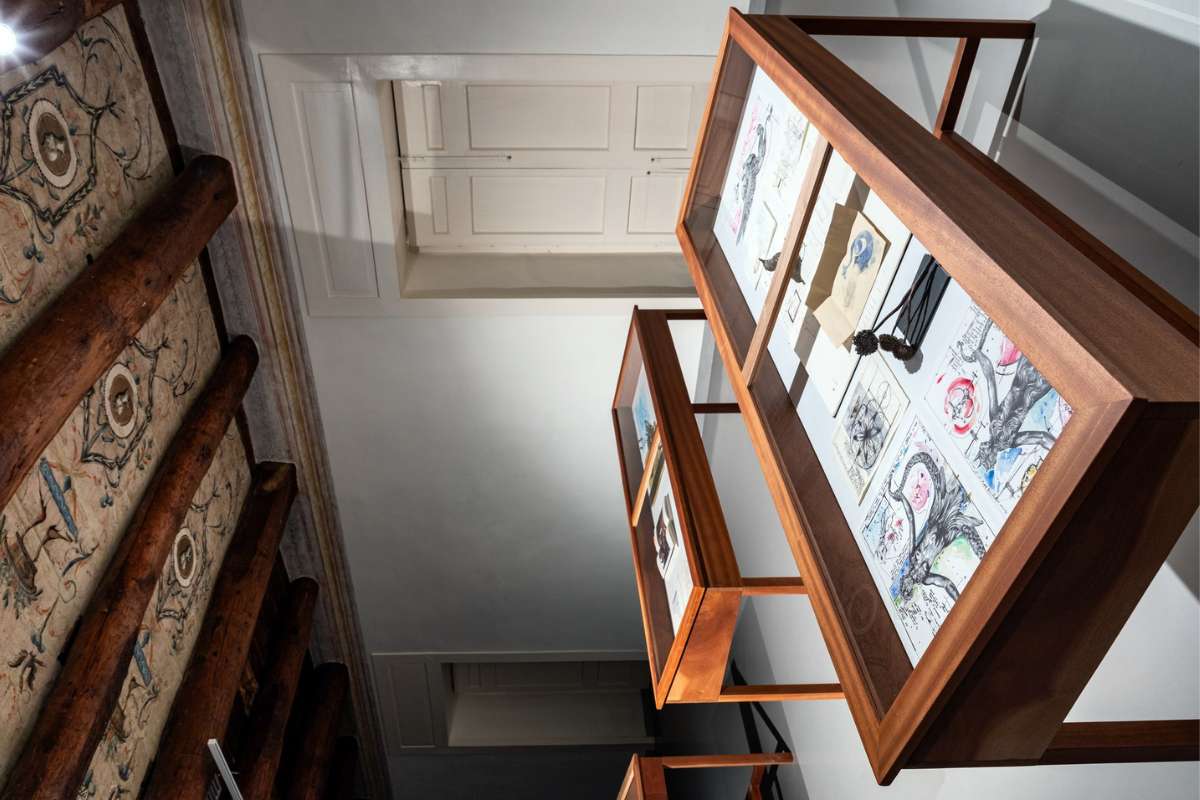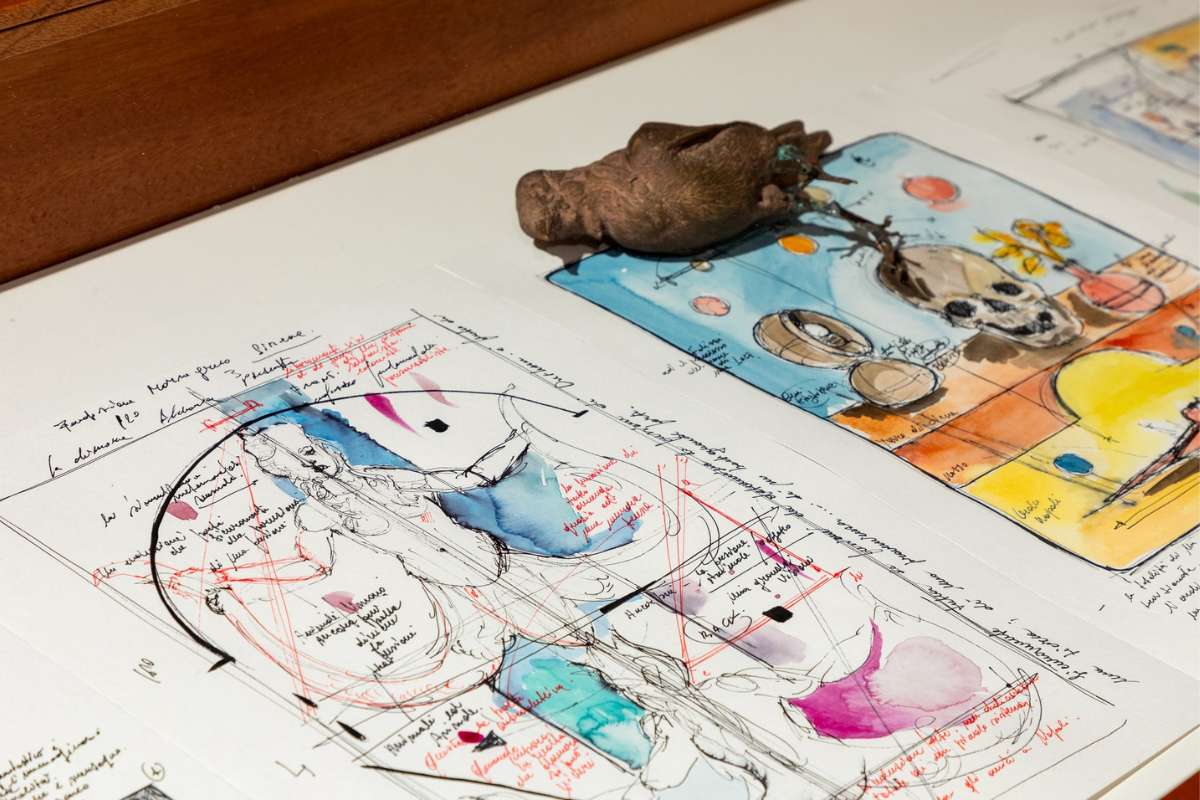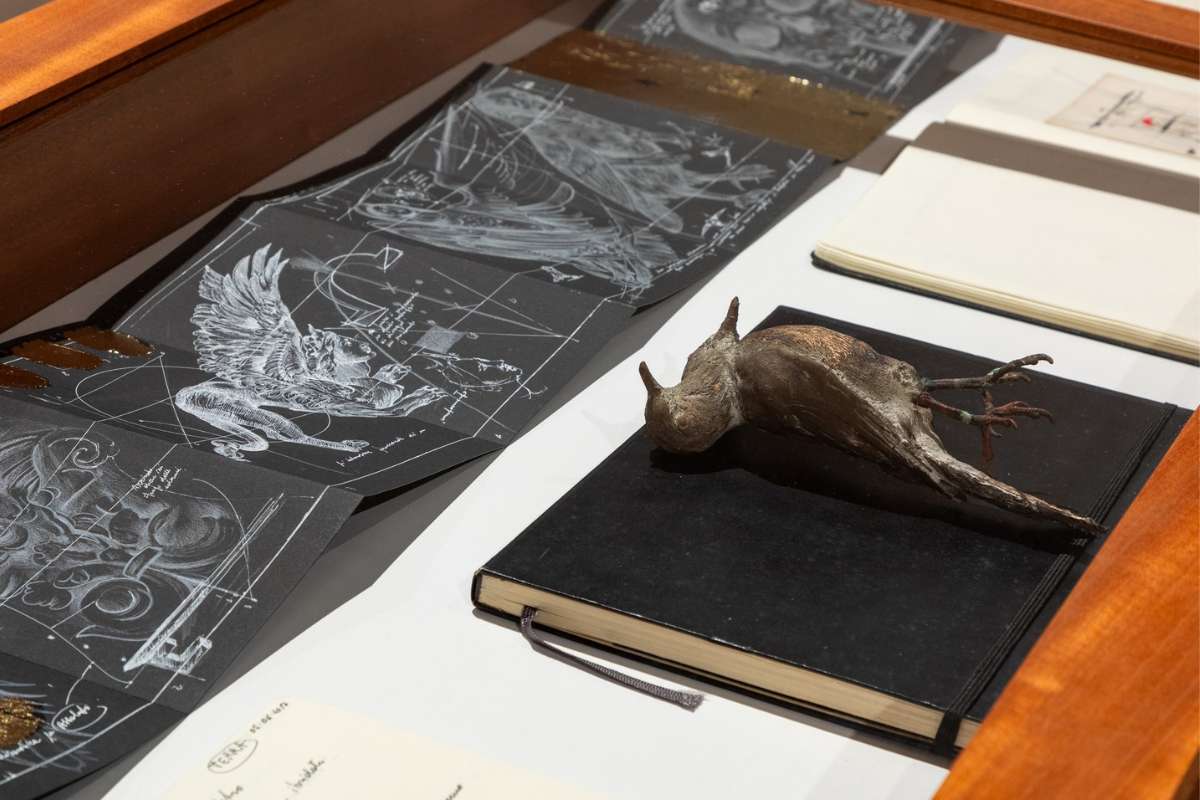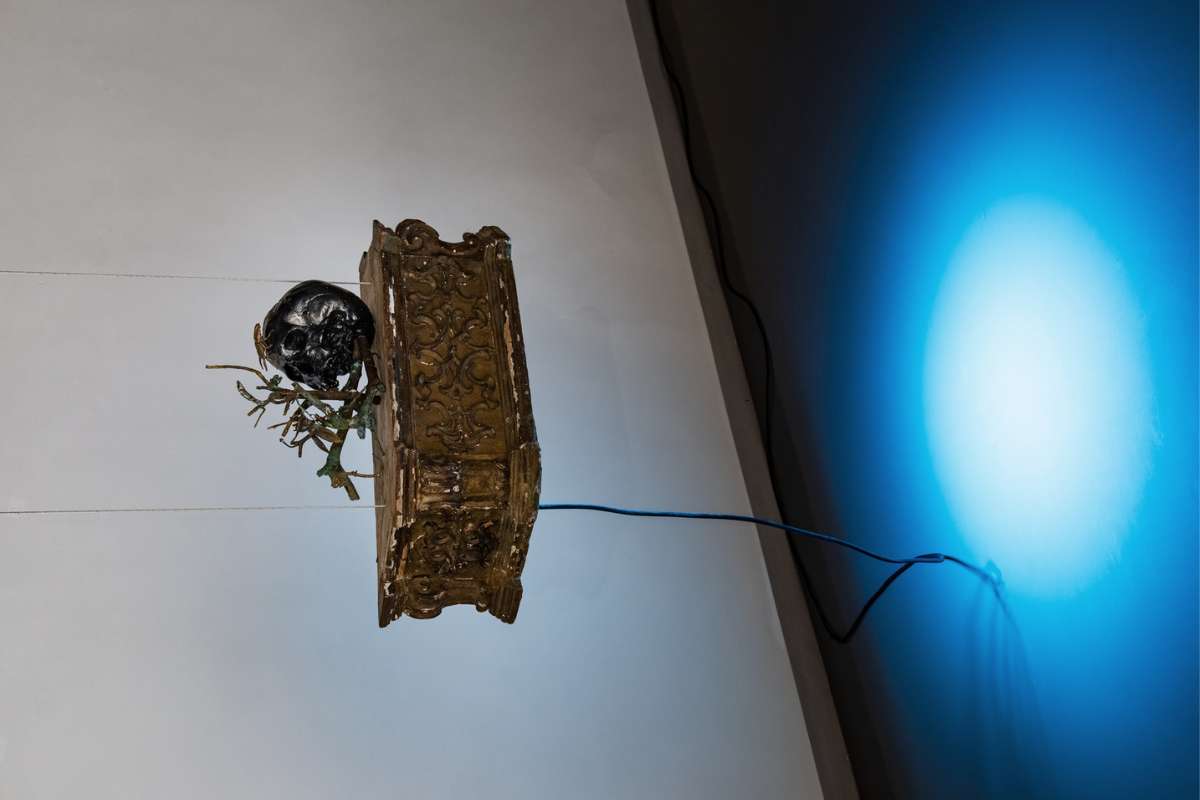22.02.2024 \\ 30.03.2024
The exhibition
Phtongos is the title of Fabrizio Cotognini’s solo exhibition unfolding in the spaces on Fondazione Morra Greco’s third floor. For the occasion, the artist conceived a new body of works starting from a study of the heraldry, symbols, and iconographies of Palazzo Caracciolo d’Avellino.
The exhibition’s title refers at once to the voices of humans, monsters, and the song of sirens. Phtongos and Ligure aoide are the two expressions used by Homer to describe the voice of the sirens, mythical figures dear to the Neapolitan and Campanian imagination. The fil rouge of the exhibition is precisely the recovery, reconstruction and representation of various anthropomorphic beings belonging to the iconography of the Sirens of the local area, starting with the ancient cult of the Siren Partenope protecting the city.
Already a Latin inscription attributed to Epicurus – “Dum Vesuvii Syren Incendia Mulcet” – refers to this mythological being by summarising the alchemical relationship between water and fire (male-female): the “Siren sweetens the ardour of Vesuvius”, a reference to the rebellions of the Neapolitan people who rose up flaming like the volcano Vesuvius.
Through his works, Fabrizio Cotognini develops a direct dialogue with some of the artistic findings uncovered during the restoration of Palazzo Caracciolo d’Avellino and leads us on a journey through human-animal, plant-animal, and plant-human metamorphoses, generating reflection on current issues such as politics, sociology and ecology.
Large drawings and tiny sculptures take over the space of Fondazione Morra Greco, giving visitors the direct possibility of a visual, but also magical, dialogue with symbolic beings that often attract our curiosity for their beauty and oddity but are hardly read for the characters they hold in terms of symbology and narrative. Keepers of ancient but also current histories, so we embark on a journey into what Agamben calls “contemporary archaeology”: where current knowledge finds its foundations in anthropology, local culture and social context.
Text by Giulia Pollicita
About the artist
Fabrizio Cotognini (Macerata, 1983) lives and works in Civitanova Marche. His research is characterized by a constant reference to the ancient revisited in a contemporary key. Time, memory, myth are central elements in his work, explored through history, literature, architecture and theatre. In his works these languages meet and merge, giving life to complex narratives in which iconography and writing enhance each other. His medium of choice is drawing, expressed on wood – often working on ancient engravings of which he is a passionate collector – in the form of an artist’s book or in work diaries.
Passionate about alchemy, he conducts tireless and methodical research and experimentation on materials and production processes for both two-dimensional works and sculpture, in particular working, in recent years, with microfusion.
Having graduated from the Academy of Fine Arts of Macerata in Painting and Sculpture in 2009, winner or finalist of several Italian artistic prizes, including Cairo prize, he began exhibiting in group exhibitions in 2003, at just twenty years old, and in solo exhibitions since 2011 in Italy. He has created site-specific projects upon invitation and commission of public institutions, including Fondazione Sandretto Re Rebaudengo, Turin; Parco dei Fori Imperiali, Rome; Palazzo Buonaccorsi, Macerata; Teatro Anatomico dell’Archiginnasio, Bologna; American Academy, Rome; Archaeological Museum, Salerno; Palazzo Ducale, Urbino; Palazzo Magnani, Reggio Emilia; Pastificio Cerere, Castel Sant’Elmo. His works have also been exhibited abroad, including at ICI, Bern; Oficina, Barcellona; Hero gallery, Amsterdam; ICI, Caracas; Centro de Desarrollo de las Artes Visuales, La Havana; National gallery, Georgia. His work has been presented in important events including the Thessaloniki Biennale, Manifesta 12, the Drawing Biennale, the Mediterranean Biennale and collateral events of the Venice Biennale.
About the curator
Lorenzo Benedetti is a curator and writer based in Paris. Recently he curated the exhibition Seth Siegelaub: textile art theory at Triennale Milan and Fondazione Ratti, Considered agreement by John Knight and Antonio Ratti dream’s, both at the Fondazione Ratti in Como where he is co-director of the CSAV Art-Lab program. He was director of de Appel arts centre Amsterdam, Art Center De Vleeshal, Middelburg, in the Netherlands, and the art center Volume! In Rome. In 2004 he founded the SoundArtMuseum in Rome. His exhibitions and projects have taken place at the Museum Marta Herford in Germany, La Kunsthalle Mulhouse, Kunstmuseum St.Gallen, Switzerland. Curator of the Dutch Pavilion for the 55th Biennale of Venice with a project by Mark Manders.
The curator’s point of view
Already from the title of the exhibition one enters the world addressed by Fabrizio Cotognini, who traces one of the most fascinating themes of the human imagination: the relationship with fantastic creatures that are lost in the depths of history. His research is linked to the context of the historic building of Palazzo Caracciolo di Avellino in the heart of the city of Naples, which is also so rich in cultural stratifications. Thanks to the restoration work carried out by Fondazione Morra Greco, the beauty of the building, in which important cycles of frescoes created in the Baroque era by Giacomo del Pò have appeared, has been restored to the public. From this context Cotognini gives us the key to access that combines with that etymological analysis that expands to a whole series of living elements in the exhibition space. Sound and drawing, reproduction and transformation, migration and survival, all unfold in a series of elements that make different times and histories visible, and at the same time make us enter a maze of possible stories. It is precisely a sound that becomes the starting point for an analysis that traces and transforms a series of recurring themes in culture from the Assyrian Babylonians to the present day. From Berio’s research on mermaids to the use of artificial intelligence, the exhibition’s soundtrack, composed by musician Riccardo Michetti, is a mosaic of sounds and elaborations that trace the subject of mermaids.
Cotognini’s activity as an assiduous draughtsman leads his work to reflect on a series of iconographic themes that dialogue directly with the past. The iconographic terms intrinsic in Cotognini’s work refer to and start from the depth of mythology crossing characters, artists and writers of different eras. A tribute to the imagination and some of its protagonists, starting with Gustavus Rol or Jimmie Durham, with his totems in which animals and objects are intrinsically linked, moving then from Gustave Moreau to Kiki Smith. An interweaving of drawings and fantastic references is continually elaborated by the artist. Using the incessant activity of drawing and writing notes and references as a tool, Cotognini plays on associations, quotations and references that lead to the contamination and alteration of reality. This attention to the surrounding context is distorted by the continuous search and recovery of historical elements that are lost in the deepest antiquity but at the same time are beside us always active or close to being activated. Taking up Jorge Luis Borges’ Handbook of Fantastic Zoology, one enters a structure of incessant historical cultural references but above all of etymological roots that seek to weave those threads of time that have woven, preserved and transformed the same sound and meaning. These traces seem to be echoed in the line of his drawings. At the center of the installation project the artist puts showcases with the details of the research that connects mythology, history, philosophy, and language into one kaleidoscopic artistic imagery. The annotations on the references but also the attention to technical aspects such as the acronyms of the colors that all have a particular symbolism.
Travel through history and time to escape the present, but at the same time bring everything back to a present focus. The quotation is a use of an existing reference that deforms the present writing. And in this game of repetition, the artist echoes Deleuze in the formulation that the only thing identical in repetition is its difference. Cotognini echoes this thought in copying and deforming reality, thus reconnecting with the enormous corpus of drôlerie elements that inhabit our collective imagination. In Cotognini’s visionary imagination we often encounter the concept of migration developed by Aby Warburg. Mythological themes and subjects are activated in different ways after centuries of transformations and passages through different peoples and cultures. In this way in Cotognini’s work we find not only that attention to ancient stories that awaken around our collective imagination, but also the action of transforming and reinterpreting these cultural journeys that always find new nests in which to reproduce. It is no coincidence that a certain kind of cultural survival, again to stay with Warburg, ties in so strongly with the biological and biomorphic concept that relates to drones. The natural world in its probable possibilities of manifestation of existence leads us to continue that imagination of the possible through a series of integrations, transformations and thus metamorphoses that place culture on the same level as biology, that is, that essential need for survival. And to face this task, culture seeks an analogy in the main biological character which is that of adaptation. Culture adapts to survive, and like nature it has two main possibilities: either it transforms or it hibernates to find better conditions in the future. This parallelism to biology poses a fundamental discourse of cultural value in relation to the contemporary.
Text by Lorenzo Benedetti

